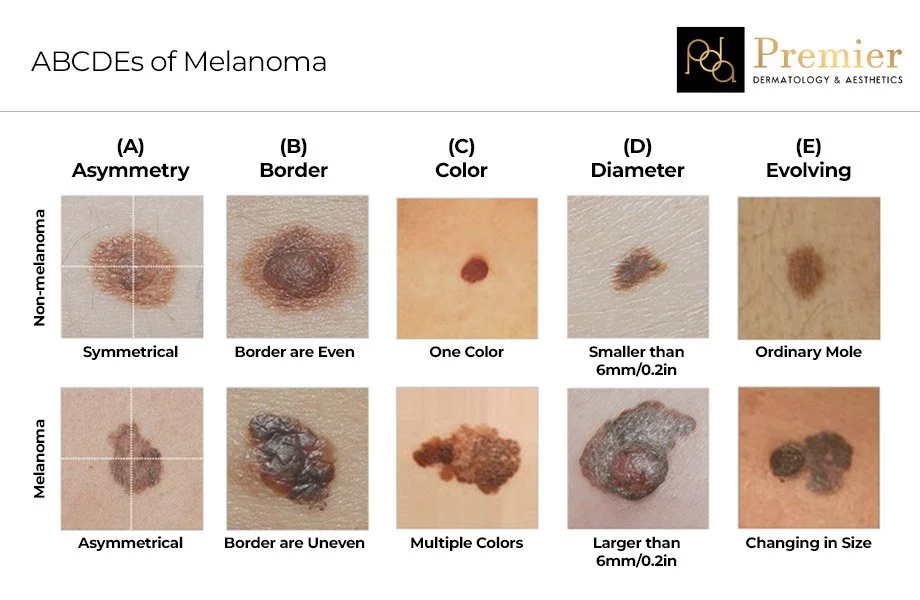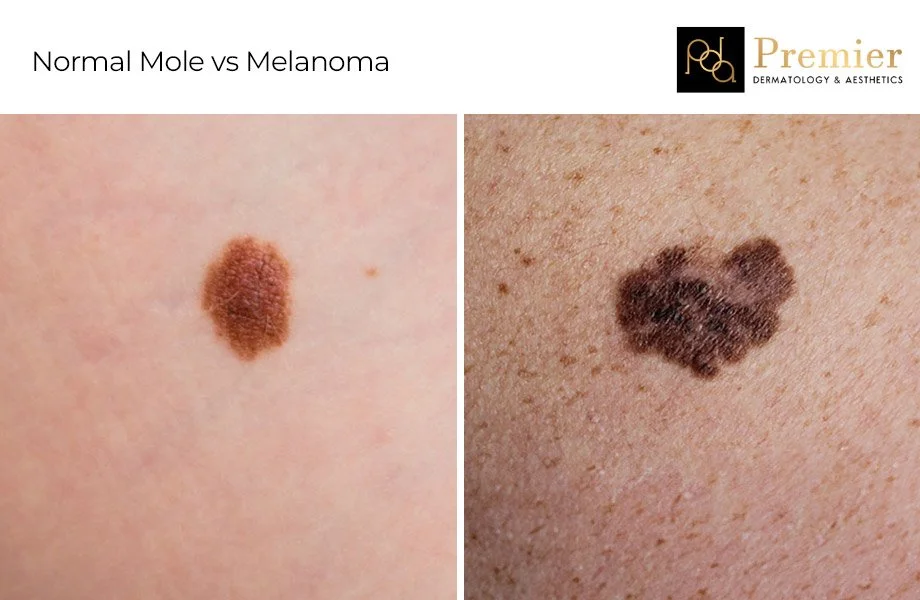The ABCDEs of Melanoma - How to Spot Suspicious Moles & Schedule a Skin Check in NYC
When it comes to your skin, early detection can be lifesaving. Melanoma, the most serious type of skin cancer, often starts as a small, seemingly harmless mole. But when caught early, it’s highly treatable. That’s why at Premier Dermatology & Aesthetics in New York, double board-certified dermatologist Dr. Adam Nabatian encourages patients to stay proactive with annual skin checks and monthly self-exams.
To make it easier for patients to recognize suspicious moles, dermatologists use a simple, effective mnemonic: the ABCDEs of melanoma. This easy-to-remember mnemonic helps you identify moles that may require a closer look.
What Is Melanoma?
Melanoma begins in the melanocytes, the pigment-producing cells that give your skin its color. Melanoma can spread quickly to other parts of the body if not detected early. It’s estimated that one person dies from melanoma every hour in the U.S., a high statistic that highlights the importance of regular screening.
The good news? When identified in its early stages, melanoma is highly treatable. That’s why recognizing changes in your moles and scheduling a professional skin exam with a dermatologist is so critical.
The ABCDEs of Melanoma
A - Asymmetry
Draw an imaginary line through your mole. If one half doesn’t match the other, it could be a sign of melanoma. Benign moles tend to be symmetrical, while cancerous ones are often uneven or irregular in shape.
B - Border
Pay attention to the edges of your mole. Melanomas typically have uneven, scalloped, or blurry borders that may fade into the surrounding skin.
C - Color
Normal moles are usually one solid color, such as tan or brown. If you notice multiple shades, brown, black, red, white, or blue, within the same mole, it’s best to have it examined.
D - Diameter
While not all large moles are dangerous, melanoma lesions are often larger than 6 millimeters, roughly the size of a pencil eraser. However, some aggressive melanomas can appear smaller, so size alone isn’t the only factor.
E - Evolving
Perhaps the most important sign of all, “E” stands for evolving. Any mole that’s changing, whether in size, shape, color, or sensation (such as itching or bleeding) should be evaluated right away.
What to Expect During a Skin Check
A professional skin exam at Premier Dermatology & Aesthetics is quick, thorough, and reassuring. Using a dermatoscope, a handheld magnifying device with a special light, Dr. Nabatian examines your skin in detail, allowing him to identify subtle pigment or structural changes not visible to the naked eye.
During your visit:
Your full-body skin will be examined from head to toe.
Dr. Nabatian will identify any atypical moles or lesions.
Photos or digital mole mapping may be used to track changes over time.
If anything suspicious is found, a small biopsy may be performed.
The process takes about 15–30 minutes and requires no downtime. Many patients find peace of mind knowing their skin has been carefully evaluated by an expert.
Who Should Get a Skin Check?
Everyone can benefit from regular skin exams, but certain individuals have a higher risk for developing melanoma. You should schedule yearly (or even biannual) skin checks if you:
Have fair skin, light eyes, or red/blond hair
Spend significant time in the sun or have a history of sunburns
Have many moles or large, irregular moles
Have a family or personal history of skin cancer
Notice any new, changing, or unusual spots
If you’re unsure when your last skin exam was, or if you’ve noticed a mole that looks different from the rest, it’s time to make an appointment.
Skin Protection and Prevention Tips
Prevention goes hand-in-hand with early detection. To help reduce your risk of melanoma, Dr. Nabatian recommends:
Apply broad-spectrum SPF 30+ sunscreen every morning, even on cloudy days
Reapplying your sunscreen every 2 hours or sooner if you are sweating, swimming, or towel drying
Avoid tanning beds and excessive sun exposure
Wear protective clothing, hats, and sunglasses outdoors
Perform self-exams monthly, using a mirror for hard-to-see areas
Take photos of your moles to track any changes over time
Being proactive with your skin health is one of the most important things you can do for long-term wellness.
Schedule Your Skin Check in NYC
Your skin tells an important story and we’re here to help you read it. At Premier Dermatology & Aesthetics, Dr. Nabatian combines medical expertise with advanced diagnostic tools like the dermatoscope to ensure you receive the most accurate evaluation possible.
Contact us at: https://www.pdskincenter.com/contact or call (212) 433-3788 to make an appointment.
Don’t wait for changes to become problems, book your professional skin check today and take the first step toward protecting your skin’s health and your peace of mind.


